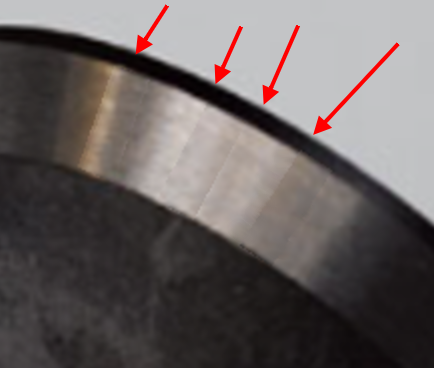What Are "Chatter Marks" on a Valve?
Imagine you're coloring a picture with a brand new crayon, and the paper is nice and smooth. The color goes on perfectly! Now, imagine you try to color that same picture while riding in a bumpy car, and your hand is shaking a little. Instead of a smooth line, you'd get a line that looks wavy, bumpy, and uneven, right?
That's a lot like what happens when grinding an engine valve.
What are Chatter Marks?
A valve refacing machine has a super-fast spinning grinding wheel that shaves off a tiny, tiny amount of metal to make the valve face perfectly smooth and perfectly angled so it seals well.
If everything is going smoothly, the valve face ends up looking like a mirror—it's super shiny and perfectly flat.
But if the machine shakes, vibrates, or wiggles even a very tiny bit while it's grinding, it leaves behind those bumpy lines. These lines are called chatter marks.
Chatter marks are tiny, wavy, or zigzag lines etched onto the smooth face of the valve. They look like a ripple in water. If a valve has chatter marks, it can't seal properly, and the engine won't run as strongly or as smoothly as it should!

How to Get Rid of the Bumps! (Checking the Machine)
If you see chatter marks, you know the machine, not the valve, is the problem. Something is probably loose on the machine! Here are some things to check and change on the valve refacing machine to stop the chattering:
1. The Grinding Wheel is the Problem
- Is it Dull? If the grinding wheel is old, worn out, or has dirty stuff stuck to it, it won't cut smoothly. It will just bounce and scrape.
- What to Check: Use a tool to "dress" the wheel, which means making its surface perfectly sharp, clean, and flat again.
- Is it Loose? The wheel has to be held in place very tightly. If the nut holding it on is a little loose, the wheel will wobble and chatter.
- Are any movable components Loose? The grinding machine likely has several places for adjusting the sections of the machine that move the valve or grinding wheel. If these are not adjusted correctly they are a likely cause of chatter marks. (see your machine manual for instruction of what and how to adjust your machine)
- What to do? Look in your owners manual and check all of the various adjusting points.
- Is the Chuck worn out? Runout is the main indication of a worn chuck. A worn out chuck is not likely to produce chatter.
- Movement is what to look for. Check where the chuck is held to the machine, is it secured as your manual indicates? Check the motor drive train that turns the chuck. Check the drive motor mounting. Check the devices that move the valve during grinding and/or what moves the grinding wheel.
The bottom line here is that something is loose and needs to be adjusted tighter or is too tight and needs to be a little looser.
2. The Machine is Shaking
- Is the Valve Held Tight? If the chuck is dirty or isn't squeezing the valve tightly enough, the valve can wiggle.
- What to Check: Clean the chuck jaws and make sure they are squeezing the valve tightly.
- Too Fast or Too Deep? You have to be careful about how fast the valve is spun and how quickly the grinding wheel is pushed into the metal. If you try to cut too much metal too fast, the machine will fight back and start vibrating.
- What to Adjust: Slow down the feed rate (how fast you move the valve across the stone) and only take very tiny amounts of metal off at a time.
- Is the Coolant Right? The coolant keeps the metal from getting too hot and helps wash away tiny metal bits. If the coolant is dirty or not flowing right, the valve gets too hot, which can cause the chatter.
- What to Check: Make sure the coolant is clean and that the nozzle is squirting it right onto where the grinding is happening.
Over time some machine adjustments can become out of adjustment and cause chatter to creep in. Fixing these small problems helps the machine work smoothly, leaving the valve face perfectly shiny, ready to seal tight, and get the engine running great!
